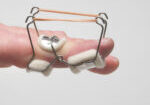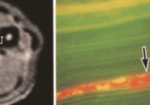Increasing Shoulder Range of Motion by improving Scapulohumeral Rhythm
Filed under Treatments
Scapulohumeral rhythm is often the key component when treating shoulder conditions and the reason for the lack of total shoulder range of motion. This may also be a critical component in order to prevent shoulder conditions during rehabilitation of other upper extremity conditions such as distal radius fractures, tendon injuries, and elbow injuries.
Scapulohumeral rhythm is the rhythm in which our scapula moves, in relation with the humerus in the glenohumeral joint as a means for shoulder mobility (glenohumeral rhythm). The standard ratio is often recognized as 2:1. This means for every 2 degrees the humerus moves, the scapula moves 1 degree. However, this ratio varies among individuals.
What is scapulohumeral rhythm?
A scapulohumeral dysrhythmia is an abnormality in a physiologic rhythm of the movement between the scapula and the humerus when moving the arm in any plane of movement. This can present in a variety of ways such as winging of the scapula, a shrug sign, scapular adduction, or scapular abduction during shoulder movements (scapular humeral rhythm).
“Treatment focuses on practicing perfect reps, even if total range has to be decreased.”
Examination: The LSST
If you have a patient with a significant decrease in shoulder range of motion in any of the planes of movement the rhythm could be a primary concern for the therapist. If the therapist suspects that this may be the problem, having the patient complete the Lateral Scapular Slide Test (LSST) can help to helpful. This can demonstrate the location of the asymmetry in the rhythm.
The 3 primary positions for the LSST are:
· Position 1, the patient’s arm is relaxed at their side (0 degrees of humeral elevation)
Position 2, the patient places their hands on the lateral iliac crest. This motion places the arm in approximately 60 degrees of abduction. Following the 2:1 ratio rule, this means the humerus is responsible for 40 degrees of motion (abduction) and 20 degrees of motion on the scapula (upward rotation)
.
Position 3, shoulder abduction at 90 degrees with internal rotation. Following the 2:1 ratio rule the humerus would be responsible for 60 degrees of motion (abduction) and the scapula would be responsible for 30 degrees of motion (upward rotation).
This quick screen can assist the therapist in identifying any scapulohumeral dysrhythmia during these aforementioned movements.
Treatment:
Treatments vary from person to person when it comes to their overall strength, range of motion, and tolerance. When a dysrhythmia is exhibited, however, some common treatments may include:
· Supine air punches
o Description: With patient in supine on the therapy table, have them flex their shoulder to 90 degrees. Then have them protract the shoulder by “punching the air,” weight may also be added as patients progress.
· Foam roller on the wall/table
o Description: Patient is in standing facing a wall with a foam roller. They are instructed to flex their shoulder to hold the foam roller against the wall, then have them roll it up the wall while maintaining good mechanics and not allowing a shoulder hike/elevation.
· Resisted low row pulls w/ theraband
o Description: With the patient in standing facing a doorway, trap the theraband in the hinge side of the door. Have them grab the theraband ends and pull towards them (retraction) by driving the elbows back. This engages the scapular muscles while maintaining good mechanics. Do not allow a shoulder hike/elevation or a lean backwards.
There are some common cues that are often given to patients which include:
“Keep your shoulder down” or
“put the shoulders in their back pockets” and/or
“hold a peanut or a dollar bill between your shoulder blades”
Mechanics are key. The focus of these treatments is for slow controlled mechanics in order to improve motor planning and neuromotor recruitment to the muscles around the scapula. Treatment focuses on perfect reps, even if total range has to be reduced. Keep an eye on the mechanics of the patient and cue as needed if mechanics degrade.
Reestablishing the typical 2:1 scapulohumeral rhythm will improve total range of motion, decrease pain and improve functional independence.
More To Read
Graded Motor Imagery in Hand Therapy
The 3 Stages of Graded Motor Imagery We’ve all heard of mirror box therapy, but do you know the details of how it works? There’s actually 3 stages involved that exercise the brain and take advantage of its plasticity. There is a great deal of evidence supporting these three stages and you can use them…
Read MoreManagement of the Stiff Finger: Evidence and Outcomes
Title: Management of the Stiff Finger: Evidence and Outcomes Reference: Yang, G., McGlinn, E. P., & Chung, K. C. (2014). Management of the stiff finger: Evidence and outcomes. Clinics in Plastic Surgery, 41(3), 501–512. https://doi.org/10.1016/j.cps.2014.03.011 Article Review By: Tommi Hintnaus The Skinny: This study focuses on understanding and managing finger stiffness, a condition characterized by…
Read MoreMechanism of Interneural Edema in Carpal and Cubital Tunnel
Mechanism of Interneural Edema Over the last few weeks I have been learning about ultrasonic imaging and carpal tunnel syndrome. When reviewing carpal tunnel syndrome, I learned that intraneural edema is a common sign of compression injuries such as carpal tunnel and cubital tunnel. There are numerous causes of carpal tunnel syndrome, and every scenario…
Read MoreWrist Proprioception Ideas for Hand Therapy
Wrist Proprioception Intervention Ideas: By Ammie Ingwaldson Lack of wrist proprioception exercises can affect clients in the hand therapy setting with neurological and musculoskeletal conditions. Proprioception limitations are found in common conditions such as carpal tunnel syndrome, distal radius fracture, and CRPS (Valdes, Naughton & Algar, 2014). Proprioception is necessary during daily tasks to provide…
Read MoreSign-up to Get Updates Straight to Your Inbox!
Sign up with us and we will send you regular blog posts on everything hand therapy, notices every time we upload new videos and tutorials, along with handout, protocols, and other useful information.






